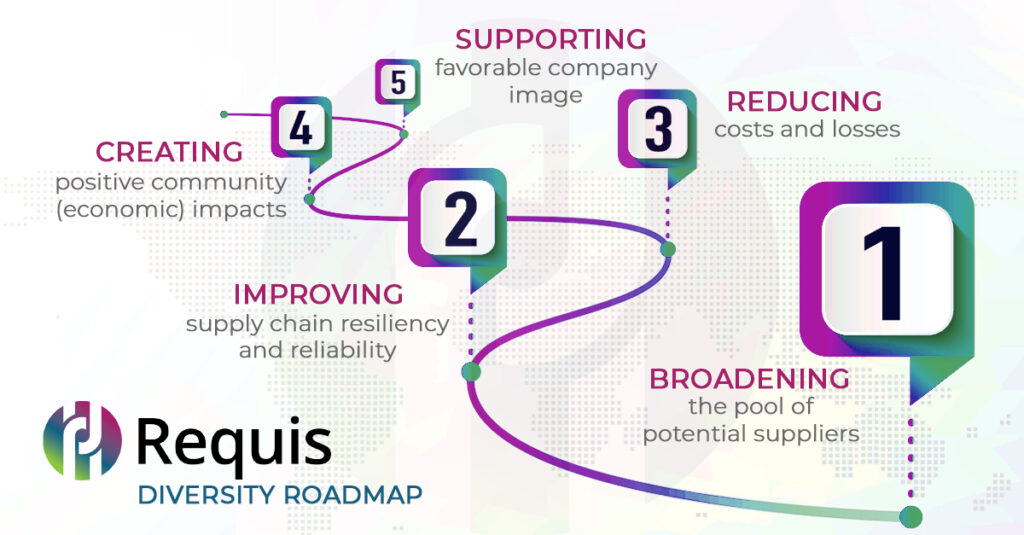September 28, 2022
Supplier diversity programs improve ESG performance
Companies are under pressure to improve their ESG performance to investors, the government, and the public. Besides environmental practices, ESG initiatives include developing supplier diversity programs.
Such policies address creating supply chain and procurement plans with diverse groups, such as minority- or indigenous-group-owned businesses.
Implementing a supplier diversity program is a top priority. But, most of all, it is an organizational journey.
Here is a road map to implementing a successful supplier diversity program.

1. Create top management support and buy–in
Supplier diversity programs need C-suite-level champions who are the voice of the initiative. They are responsible for attaining sufficient funding and driving internal and external support.
Currently, many organizations are creating diverse policies and cultures. Extending this thinking into procurement services fits well within these plans.
Equally important, supplier diversity programs must have measurable ROIs. As a business priority, program metrics and goals are clearly outlined and include:
- Broadening the pool of potential suppliers
- Improving supply chain resiliency and reliability
- Reducing costs and losses
- Creating positive community (economic) impacts
- Supporting favorable company image.
2. Define program policies and goals
Procurement services require standard policies. Such a supplier standard policy could require that 20% of RFXs are sourced from a diverse company. For example, Drax Group’s Yorkshire carbon-capture (CC) project has allocated 80% of materials and service contracts to local businesses.
This directive sets an explicit goal and is an RFx standard. Most appreciably, this directive will bolster the Yorkshire and regional United Kingdom economies.
In particular, companies must find and enlist diverse suppliers into their networks. In this step, technology will be a valuable tool. One option is to explore solutions others use to build their supplier diversity program. Likewise, industry associations and conferences are information sources.
Finally, businesses can host their supplier events to connect with new businesses. The Drax Group, its EPC company Worley, and procurement-technology provider Requis held several “meet the engineers” events in planning the Yorkshire CC project. These meetings provided information for local and minority-owned businesses to actively participate in contract processes.
3. Invest time, talent, and funding
Besides a C-level champion, supplier diversity programs need a firm budget. Businesses must build their supplier network to meet present and future RFXs. Investing in innovative technologies will enable reviewing and ranking suppliers based on their ESG progress and diversity status.
Standard procurement processes allow all parties access to real-time information. More appreciably, digital platforms and supply chains provide much-needed transparency for buyers and sellers, thus reducing costs and improving the resiliency of supply chains.
Supplier diversity initiatives should include funding for training and mentoring of suppliers. Training builds trust between the buyers and the suppliers. For many companies, digitalization is a significant change. Providing regular global training for RFXs processes maximizes new supplier performance and satisfaction.
Building a diverse supplier network requires significant time and funding. Innovative technologies can efficiently identify and vet minority-owned businesses. In addition, supplier diversity programs need flexibility to meet future ESG initiatives.
4. Review procurement processes and standards
Organizations should regularly review procurement processes and standards. Software and hardware are constantly evolving and modifying communication practices across enterprises and connections to suppliers.
Consequently, organizations must be keenly aware that today’s solutions can become quickly outdated. Periodic reviews of best practices keep the supplier diversity policies on track.
5. Come up with KPIs to measure performance
Companies maintain KPIs to optimize organization performance; the same thinking applies to supplier diversity. Consequently, the needs of the business and the providers will change. In particular, the performance metrics will shift due to internal or external forces.
Therefore, just establishing a supplier diversity program is not enough. Such programs must be regularly measured, evaluated, and updated. Such metrics include:
- Number of diverse suppliers in the network
- Percentage of RFXs submitted and accepted from diverse suppliers.
Start a Supplier Diversity Program
In short, start planning a supplier diversity program and expect change and setbacks. Digital technologies will play a vital role in this process.
Most appreciably, companies should seek solutions that will grow with the organization. Above all, conduct reviews and measure progress from internal customers and suppliers.
In closing, digital procurement operations can efficiently integrate supplier diversity into business processes and culture.
Schedule a procurement software demo today
New technologies such as Requis’ digital platform are essential in managing growing volumes of data into information in real-time and distributing it to a widening network of users.
The Requis platform streamlines the overall RFQ process. To learn more about Requis and how we can simplify and support supplier diversity for your procurement efforts, please reach out here.
